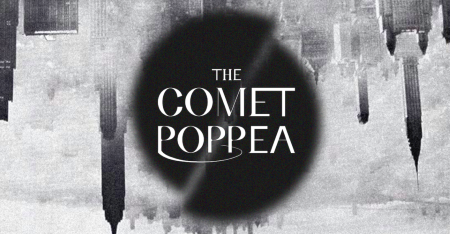BOTH YOUR HEAD AND THE STAGE WILL BE SPINNING
When The Industry’s new opera, The Comet / Poppea, a smash-up between Claudio Monteverdi and Giovanni Busenello’s 1643 L’incoronazione di Poppea and George Lewis and Douglas Kearney’s The Comet began, I developed a sinking feeling. Both operas are performed simultaneously, but I was seated on the side viewing Poppea, meaning I was missing Comet. Was I going to have to see this a second time? I needn’t have worried. After the operas finished their introductions, a stagehand came down and pushed the set into motion, continuously rotating and letting us see both operas. Well, parts of them. began, I developed a sinking feeling. The Comet, by the way, is based on the 1920 science-fiction short story by sociologist and Pan-Africanist civil rights activist W.E.B. Du Bois, set in 1920s New York City when a Black man and white woman are the only survivors after a comet hits Earth. Poppea is about social divisions of ancient Rome.
Joelle Lamare (Austin Richey)
Nardus Williams and Anthony Roth Costanzo (Austin Richey)
Mimi Lien’s set was already impressive before it started rotating. Poppealand was like some high-class spa, white-tiled stairs leading up to a throne-like tub and huge white flowers on the wall. Cometland was set in a 1920s high-rise restaurant, with lots of red and wood décor. I appreciated her attention to detail, such as a period-correct phone, but lamented that she went for recessed lighting (that was developed in the ’˜40s).
Kiera Duffy (Austin Richey)
Davóne Tines (Austin Richey)
Just as impressive was John Torres’s lighting. While the set was spinning, his lighting was constantly alternating between cool daylight in Poppealand and Cometland’s warm tungsten, and had to do it twice for both audiences. Special lighting effects, moonlight streaming into the restaurant and a splash of blood red on the spa flowers were wonderfully atmospheric. For the most part, it all stayed in sync.
Amanda Lynn Bottoms, Nardus Williams, and Lindsay Patterson (Austin Richey)
Amanda Lynn Bottoms and Nardus Williams (Austin Richey)
Given the racket the moving set made, it was understandable that the show was amplified. It used face microphones, but at least they were short and relatively unobtrusive. Mark Grey’s sound design was all over the place, but interesting. Regardless of whether we could see, Cometland’s sound always took precedence. Poppealand, not so much. Their amplification was more like reinforcement. Most of the time we heard them clearly only when we saw them; when viewing Cometland, they were often a distant echo. I wasn’t sure how much I was supposed to pay attention to Poppealand (not knowing Italian, it’s all gibberish, anyway), but I especially liked that Poppea’s sound was routed through Cometland’s radio. It made them seem connected as if by some wormhole.
Laurel Irene and Cedric Berry (Austin Richey)
Laurel Irene (Austin Richey)
All this back and forth demanded us to make connections between the two. What they were, though, consistently eluded me. There were times where it seemed that I was close, as when Poppealand would begin to say something interesting, but then they’d rotate out and put me back in Cometland. If Poppea was sung in English, I would have been able to follow a lot better. Translations were placed on screens everywhere, but were fairly useless. I’m supposed to keep track of two shows simultaneously AND read? Forget it. Do it all in English.
The Comet / Poppea (2024) (Austin Richey)
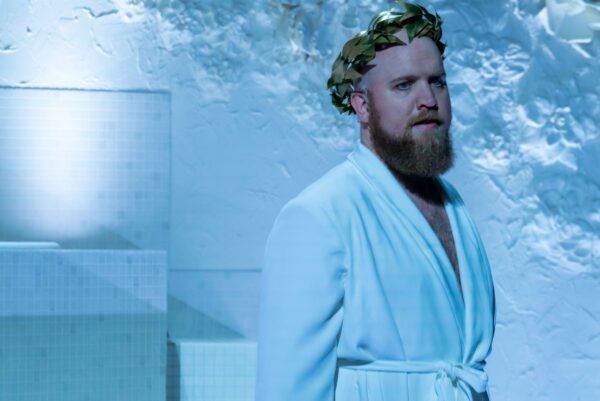 Eric Jurenas (Austin Richey)
Eric Jurenas (Austin Richey)The Comet turned out to be another tuneless new opera slowly sung. How slowly? There are dead bodies strewn about the restaurant. It took until scene three, at least twenty minutes in, for someone to finally ask, “What has happened?” The opera was far from torturous, though; Poppea’s glorious music was always just around the curve to distract from The Comet.
Cedric Berry (Austin Richey)
Laurel Irene (Austin Richey)
I saw one of the performances with the beautiful second cast. Eric Jurenas played Nero with such potent virility and flashes of bare leg from his open-front robe that he didn’t need a crown to enforce his place as Emperor. Whitney Morrison stood out as the vengeful Ottavia. James Hayden had a memorably splashy suicide as Seneca, whose blood luridly ran down the spa’s steps. Regretfully, Amanda Lynn Bottoms was miscast as Ottone, Poppea’s spurned (and male) lover. Her singing, behavior, hair, costume, all said “female,” which made Ottavia’s threat of a rape accusation confusing, until I remembered that he is supposed to be played by another countertenor. Nardus Williams played Poppea, but I mostly saw her soaking in the tub. Over in Cometland, Davóne Tines and Kiera Duffy played the almost-lovers with clear diction and convincing post-calamity acting. Joelle Lamarre was heartbreaking as Nellie, singing over her dead baby.
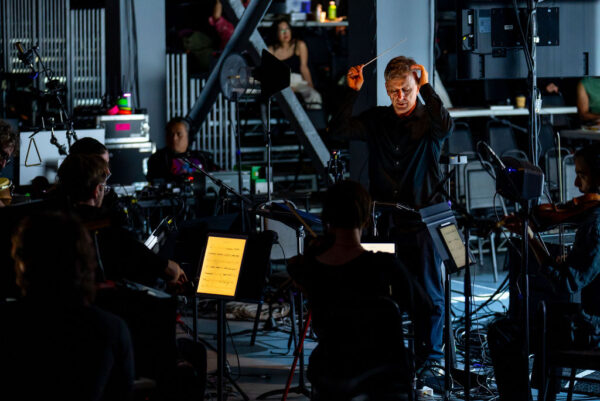
Marc Lowenstein and the Orchestra (Austin Richey)
There was a definite racial component, but I couldn’t make sense out of it. In Poppealand, the men were white and the women were black. Cometland had no such clear demarcation, but it’s population, too, was strictly white/black. When the lovers paired up into their final forms, Nero/Poppea (white/black) and Jim/Nellie (black/black), with no clear relationship to each other, I gave up.
Anthony Roth Costanzo and Nardus Williams (Elon Schoenholz)
I was looking forward to the orchestration and how the two operas were going to be simultaneously playing. However, Yuval Sharon’s staging was so compelling that I kept forgetting to take note of the orchestra’s wonderful playing, led by Marc Lowenstein. I did manage to pay attention long enough to enjoy Gabriel Crist’s furious playing on the harpsichord.
Gabriel Crist on harpsichord
Davóne Tines (Elon Schoenholz)
Near the end, the set stopped rotating, and we got a “split-screen” view of both operas. I wasn’t sure if it was planned, but, given the random nature, I wouldn’t have been surprised. This left Cometland performing to the orchestra and Poppealand performing to the wall. It was like being stuck on a ride at Disneyland that’s broken down. The animatronics keep going, regardless of the presence of an audience, and it becomes clear that they’re not performing for you. A strange feeling. A stage hand eventually ran down and shoved the set back into motion. Alas, a few minutes later, the set’s elevator doors got comically stuck. I could just picture someone cursing at them.
Davóne Tines (Elon Schoenholz)
A full production of Poppea takes about four hours. When I first saw it at LA Opera in 2006, the breathtaking love duet that concludes the opera left me stunned. So, when the rotating set finally stopped, but stopped with a view on Cometland, my heart sank. However, my disappointment was brief. That ecstatic duet turned into dual duets, Jurenas and Williams singing the original Italian, and Tines and Lamarre singing the same duet, but in English. A beautiful scene.
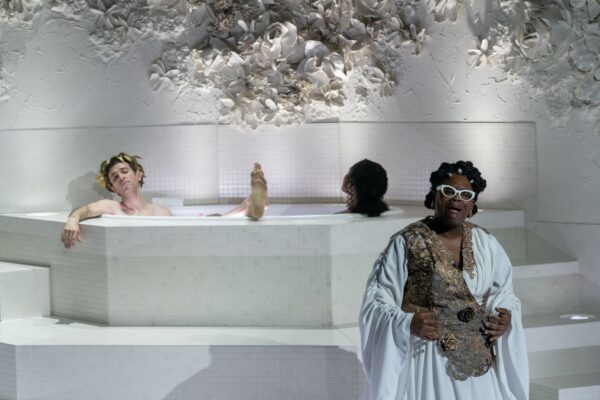 Anthony Roth Costanzo, Nardus Williams, and Whitney Morrison (Elon Schoenholz)
Anthony Roth Costanzo, Nardus Williams, and Whitney Morrison (Elon Schoenholz)My friend and I left feeling confused, but pleasantly so. That’s solid praise, given most of the new operas I’ve seen this year. Later, at home, I finally read Yuval Sharon’s notes in the program. He got the inspiration for The Comet / Poppea while working on his fascinating production of John Cage’s indeterminate Europeras I and II. Now it made sense. This show didn’t mean anything at all!
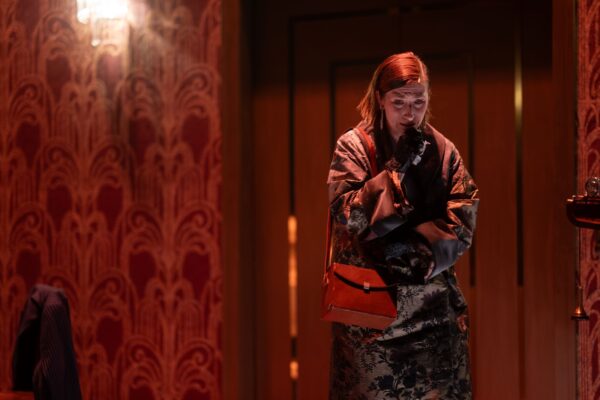 Kiera Duffy (Elon Schoenholz)
Kiera Duffy (Elon Schoenholz)The Comet/Poppea
The Industry
The Geffen Contemporary at MOCA, 152 North Central Ave, downtown L.A.
ends on June 23, 2024
for general admission tickets ($25-$40), visit MOCA
